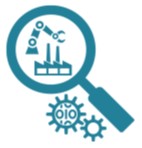|

|
Operational Knowledge from Insights and Analytics on Industrial Data
OK-INSAID (2018 - 2021) |
The main objective of OK‐INSAID is to demonstrate the innovation potential of
Big Data Analytics and Transparent Automation to transform existing
manufacturing processes, systems and related business models. It will
demonstrate the potential of Big Data technologies’ and autonomous robotics in
the value chain, benchmark results, and evaluate their replicability and
transferability to other manufacturing sectors not addressed in the proposal,
Manufacturing or not.
The project will strive to demonstrate how data technologies and autonomous
robotics applied in the manufacturing sector can streamline processes, achieve a
step gain in efficiency and resource utilisation, and act as a basis for the
provision of new digital services, mainly Open Source and delivered both at
Edge and on Cloud.
|
|

|
REnaissance of Places with Innovative Citizenship and Technolgy
REPLICATE (2016 - 2021) |
The objective of REPLICATE is to demonstrate Smart City technologies in energy, transport and ICT in districts in San Sebastia, Florence and Bristol addressing urban complexity and generate replication plans in other districts and infollower cities of Essen, Nilufer and Lausanne.Main challenges for cities are to increase the overall energy efficiency, to exploit better local resources in terms of energy supply and demand side measures. For successful implementation of Smart City technologies two main elements areconsidered:- Cities are the customer: considering local specificities in integrated urban plans and the need to develop monitoring systems to extract conclusions for replication.- Solutions must be replicable, interoperable and scalable.REPLICATE considers also the complexity of cities, the tangible benefits for citizens, the financial mechanisms and the new business models. The 3 pillars implemented in the pilots with the engagement of citizens, private actors and authorities are:- Low energy districts: cost-effective retrofitting, new constructive techniques with optimal energy behaviour and highenthalpy RES in residential buildings. Include also efficient measures in public and residential buildings: ICT tools, PV, shading or natural ventilation; district heating is demonstrated hybridising local biomass, recovered heat and natural gas.- Integrated Infrastructure: deployment of ICT architecture, from internet of things to applications, to integrate the solutions in different areas. Smart Grids on electricity distribution network to address the new challenges, connecting all users:consumers, producers, aggregators and municipality. Intelligent lighting will allow automated regulation of the amount of light and integration of IP services via PLC.- Urban mobility: sustainable and smart urban bus service, electric urban bike transport, 3-wheeler delivery and transport services, deployment of EV charging infrastructures and ICT tools.
|
|

|
Wireless Autonomous, Reliable and Resilient ProductIon Operation ARchitecture for Cognitive Manufacturing
AUTOWARE (2016 - 2019) |
Current practice is such that a production system is designed and optimized to execute the exact same process over and over again. The planning and control of production systems has become increasingly complex regarding flexibility and productivity, as well as the decreasing predictability of processes. The full potential of open CPS has yet to be fully realized in the context of cognitive autonomous production systems. SMEs face additional challenges to the implementation of “cloudified” automation processes. While the building blocks for digital automation are available, it is up to the SMEs to align, connect and integrate them together to meet the needs of their individual advanced manufacturing processes. Moreover, SMEs face difficulties to make decisions on strategic automation investments that will boost their business strategy. AUTOWARE objective is to build three distinct pillars to form a multi-sided ecosystem. (1) From the BeinCPPS, leverage a reference architecture (fully aligned with CRYSTAL and EMC2 CPS design practices and ARROWHEAD cloudification approach) across I4MS competence domains (cloud,CPPS, robotics), acting as a glue that will attract potential users and developers to a friendly ecosystem for business development, more efficient service development over harmonized architectures (smart machine, cloudified control, cognitive planning- app-ized operation). (2) To leverage a number of SME enablers; e.g. augmented virtuality, reliable wireless communications, CPPS trusted auto-configuration, smart data distribution and cognitive planning to ease cognitive autonomous systems. Finally, to leverage digital automation investments. AUTOWARE brings together the best of breed ARTEMISIA/ECSEL platforms, I4MS innovation, SAFIR business platforms and neutral experimental sites (robotics & process). AUTOWARE assets will be evaluated in two industrial pilots, PWR and SCM, and will offer well established industry and start-ups new business opportunities.
|
|

|
Servizi Ict iNTegrati per il bEnessere di Soggetti frAgili
INTESA (2016 - 2019) |
Il progetto, finanziato dalla regione Toscana all’interno del programma FAR-FAS 2014, si colloca nel settore applicativo delle tecnologie ICT innovative e non invasive per lo sviluppo di servizi personalizzati mirati al miglioramento della qualità della vita in soggetti fragili. I servizi proposti si basano sull’uso di tecnologie sensoristiche, indossabili ed ambientali, oltre all’uso di dispositivi mobili personali, per l’identificazione del livello di benessere di un soggetto da un punto di vista funzionale, clinico, cognitivo e psico-affettivo, monitorandone i comportamenti su breve e lungo termine e fornendo opportuni stimoli e feedback per il miglioramento della propria qualità della vita. I dati raccolti dai vari servizi saranno integrati in un sistema informativo centralizzato per la caratterizzazione del soggetto attraverso opportuni protocolli di comunicazione e politiche di sicurezza e privacy dei dati.
|
|
SIGS |
Sistema integrato geotermico solare di riscaldamento e raffrescamento in logica smart grid
SIGS (2017 - 2019) |
Il progetto propone l’integrazione della fonte geotermica a bassa temperatura, contenuta nel sottosuolo in falde acquifere multistrato e sedimenti, ed il solare fotovoltaico ad integrazione dell’alimentazione elettrica delle pompe di calore (PDC) geotermiche. Per l’estrazione del calore geotermico a bassa profondità si opera su falde acquifere attraverso pozzi di produzione e reiniezione con tecnologie di perforazione e completamento pozzi innovativi.
L’attuale tecnologia delle PDC geotermiche a circuito aperto presenta necessità di innovazione tecnologica nelle tecniche di pompaggio e reiniezione di fluidi in acquifero, per risolvere le problematiche legate al trasporto di solidi (limi e argille), e le problematiche relative alle incrostazioni conseguenti allo scorrimento delle acque di sottosuolo negli impianti (dai pozzi alle PDC). L’energia termica prodotta dall’impianto dimostratore alimenterà il carico termico-sanitario di un edificio ad uso direzionale e, per risolvere le asincronicità tra produzione e carico e ottimizzare la gestione tecnico-economica dell’intero sistema saranno studiati, messi a punto e realizzati dimostratori di accumuli dell’energia termica estratta. L’ottimizzazione tecnico economica dell’intero sistema, in logica smart grids, richiede inoltre una gestione razionale ed accurata delle utenze termiche mantenendo alto il benessere psico-fisico degli utenti dell’edificio. Risulta complesso “quantificare” l’impatto che diverse azioni correttive (ad esempio, sull’impianto di riscaldamento/condizionamento) hanno sui livelli di benessere psico-fisico percepiti, o quale sia il giusto trade-off tra risparmio dei consumi energetici (elettricità e/o calore) e riduzione del benessere. Saranno, quindi, ideati e messi a punto sistemi ICT innovativi per migliorare l’efficienza energetica dell’edificio nel suo complesso con l’obiettivo di migliorare i livelli di benessere psico-fisico degli utenti..
|
|

|
SoBigData Research Infrastructure
SOBIGDATA (2015 - 2019) |
One of the most pressing and fascinating challenges scientists face today, is understanding the complexity of our globally interconnected society. The big data arising from the digital breadcrumbs of human activities promise to let us scrutinize the ground truth of individual and collective behaviour at an unprecedented detail and scale. There is an urgent need to harness these opportunities for scientific advancement and for the social good. The main obstacle to this accomplishment, besides the scarcity of data scientists, is the lack of a largescale open infrastructure, where big data and social mining research can be carried out.To this end, SoBigData proposes to create the Social Mining & Big Data Ecosystem: a research infrastructure (RI) providing an integrated ecosystem for ethic-sensitive scientific discoveries and advanced applications of social data mining on the various dimensions of social life, as recorded by “big data”.Building on several established national infrastructures, SoBigData will open up new research avenues in multiple research fields, including mathematics, ICT, and human, social and economic sciences, by enabling easy comparison, re-use and integration of state-of-the-art big social data, methods, and services, into new research. It will not only strengthen the existing clusters of excellence in social data mining research, but also create a pan-European, inter-disciplinary community of social data scientists, fostered by extensive training, networking, and innovation activities. In addition, as an open research infrastructure, SoBigData will promote repeatable and open science.Although SoBigData is primarily aimed at serving the needs of researchers, the openly available datasets and open source methods and services provided by the new research infrastructure will also impact industrial and other stakeholders (e.g. government bodies, non-profit organisations, funders, policy makers).
|
|
|
|
|
| |
|

